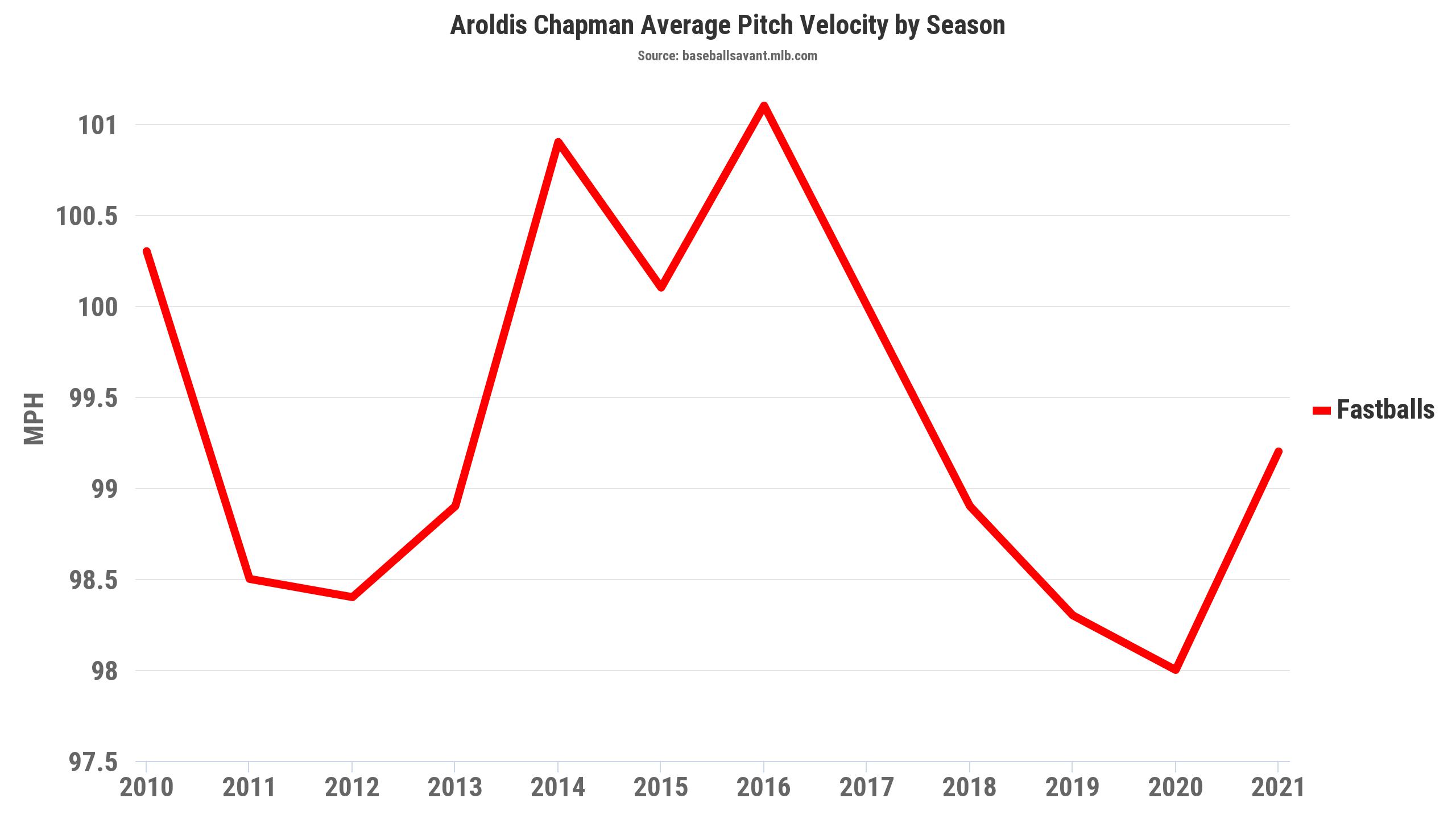Throughout the first half of the 2010s, Aroldis Chapman was inarguably one of the best relievers in baseball. After his return to the Yankees following his contribution to the Cubs’ 2016 World Series Championship, his game—while still great—took a step back. So far, in 2021, Chapman is enjoying his best season as a professional.
Before allowing a game-tying home run to Andrew Vaughn on May 23, Chapman had amazingly not allowed a single earned run in 18 innings of work. If you drafted him in fantasy, he is giving you a massive return on investment, especially for a reliever.
Off-Field Issues
Before we get into the deep dive of Chapman’s profile, there’s something I want to address briefly, as I could not bring myself to write about him without mentioning it. In 2016, Chapman was suspended for 30 games by MLB after being accused of domestic violence against his girlfriend. I don’t want to speculate on the details of the incident, but I can’t simply ignore it.
A few days ago, fellow PitcherList writer Max Greenfield wrote about Domingo Germán, another Yankees pitcher who was accused of domestic violence. In addition to insightful analysis about Germán’s success so far this year, Max included a section at the end to address Germán’s off-field issues and a general problem in baseball. I don’t think I could explain my thoughts better than Max did, but to summarize, banning Chapman from baseball would be counterintuitive, as it may create an even more harmful situation for the victim.
Chapman has had significantly more time than Germán to learn from his mistakes and grow as a person, and all we can do is hope that is the case. In general, baseball has a problem with the way certain men in power treat women; the recent stories involving Jared Porter, Mickey Callaway, and just the other day, Marcell Ozuna are just a few more examples. Hopefully, we will eventually reach the day where actions similar to those of Chapman, Germán, or Callaway are much rarer.
Fastballs
When you hear the name “Aroldis Chapman“, the first thing you think of is probably his incredibly hard fastball. Prior to the arrival of other hard-throwing relievers such as Jordan Hicks and Emmanuel Clase, Chapman was the hardest thrower in baseball by a wide margin. Nothing has changed. The fastball is still his bread and butter. Both Baseball Savant and Pitch Info classify a secondary pitch he uses a small percentage of the time as a sinker, due to its few extra inches of break compared to his typical 4-seam fastball. However, both pitches are very similar in terms of velocity, spin rate, and performance. Thus, for argument’s sake, we will consider both the 4-seamer and the sinker under the generic “fastball” umbrella for this article.

Following a gradual downward trend, Chapman’s fastball velocity is finally back. While he isn’t quite reaching triple digits consistently like he once did, I don’t think hitters are too thrilled about facing 99.5 MPH fastballs with movement. Additionally, Chapman traditionally takes a couple of months to build his velocity up and usually reaches peak performance around June or July. Therefore, we may see this number rise even higher as the season goes on.
Although Chapman may not be experiencing career-high velocity on his fastball, he is seeing career-high results. Batters have missed on 41.7% of fastballs from Chapman they swung at, the largest whiff rate of Chapman’s career, even going back to his days with the Reds. The same can be said about his 40.6 CSW%.
Unfortunately, we don’t have Statcast data before 2015, so we cannot compare his spin rate or opposing hitters’ quality of contact to the prime of his career. However, both of those measures are currently better than they have been in his previous seasons with the Yankees. Considering he isn’t throwing as hard but getting better results on his fastball, I’d assume he is spinning it better than he did in the early 2010s.
Sliders
It seems as if Chapman has worked hard on perfecting his slider over the last two years. His fastball always has been and always will be his go-to pitch, but as he has gotten older, he has needed to rely on his secondary stuff a little more. Not everyone can make a Hall of Fame career out of one pitch, like another reliever Yankee fans may be familiar with. In his previous peak, Chapman was throwing his fastball over 80% of the time and hitters couldn’t touch it. In 2021, his fastball usage has dropped to 57.3%, yet he is experiencing a similar — if not higher — level of dominance. Thus, you could argue the slider has been his key to success.
He has greatly improved the horizontal movement on his slider, as it currently carries 8.7 inches of break above average. He is inducing an incredible 71.4% ground ball rate, which is by far the highest mark in his career. This is a great sign coming off a year where Chapman gave up a concerning amount of fly balls, leading to a high home run rate. Chapman is becoming a power pitcher who can also generate weak contact, making him basically unhittable.
A New Pitch
Late in 2020, Chapman discovered a new pitch: a splitter. In 2021, he has officially added it to his repertoire, throwing it 11.5% of the time. He has traditionally been a two-pitch pitcher — he technically once had a changeup, but he threw it less than 5% of the time, so it was basically irrelevant. His splitter is purely a putaway pitch, as he pretty much never throws it when behind in the count. However, he turns to the offspeed pitch about 22% of the time on 2 strike count and has used it on 35% of 0-2 counts he has pitched in. Here, Chapman strikes out Lourdes Gurriel Jr. with a splitter.
https://gfycat.com/costlypalatabledavidstiger
If you’re a batter, you have to guess between an upper 90s fastball, a great slider, or that splitter. If you fall behind in the count, you’re basically doomed. Despite its low usage, Chapman has induced a 61.1% whiff rate on his splitter, though we are dealing with a small sample size. Either way, as a tertiary pitch, the splitter complements the fastball and slider nicely.
Is This Sustainable?
Will Aroldis Chapman finish the season with a 0.47 ERA? Very likely, no. However, he does have the tools to maintain his dominance as the season goes along. He is now a legitimate three-pitch reliever, and his fastball is back to performing like it did in 2014. Moreover, his secondary stuff is good enough where he doesn’t even need to use his fastball a vast majority of the time. This all makes me wonder: what if his slider was this good back when he was consistently pumping 102?
Photo by Mark LoMoglio/Icon Sportswire | Feature Graphic Designed by James Peterson (Follow @jhp_design714 on Instagram & Twitter)

